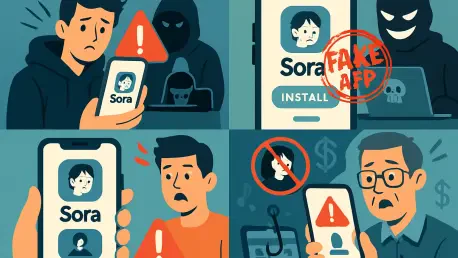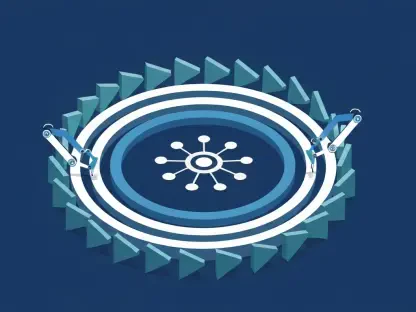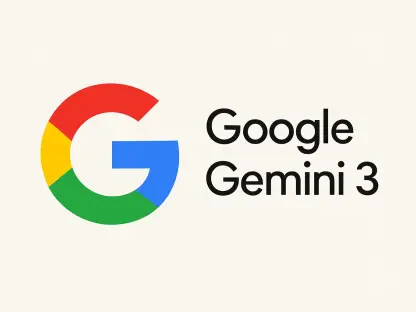In the rapidly evolving world of technology, few innovations have captured public attention quite like Sora, OpenAI’s groundbreaking AI video generator, often likened to a “TikTok for AI slop.” With an astonishing one million downloads in under five days, the app’s meteoric rise has not gone unnoticed by opportunistic scammers. Initially launched as an invite-only, free-to-download application, Sora created a frenzy among users eager to experiment with hyper-realistic video content. However, this hype has opened the door to a flood of counterfeit apps on both the iOS App Store and Google Play Store. Unsuspecting users, desperate to access the tool, often fall prey to fraudulent versions that promise instant access but deliver risks instead. This alarming trend underscores the importance of vigilance when navigating app stores, as the line between genuine and fake can be dangerously thin. Staying informed about these deceptive practices is crucial for anyone looking to explore Sora’s capabilities without compromising security.
1. Unpacking the Surge of Fake Sora Apps
The popularity of Sora has unfortunately paved the way for a wave of fraudulent apps designed to exploit eager users. According to TechCrunch, over a dozen fake Sora apps surfaced on the iOS App Store shortly after the official launch, often masquerading under names like “Sora” or “Sora 2,” the latter referencing the specific AI video model. Interestingly, some of these deceptive applications were already present on the platform under different identities long before OpenAI’s announcement, only to rebrand themselves to capitalize on the buzz. This issue extends beyond Apple’s ecosystem, with Google’s Play Store also hosting numerous counterfeit versions. Collectively, these fake apps have been downloaded over 300,000 times, with more than 80,000 downloads occurring after the official release. One particularly successful imposter, “Sora 2 – AI Video Generator,” alone accounted for over 50,000 downloads, highlighting the scale of this problem.
Beyond the sheer volume of downloads, the financial impact of these fraudulent apps is staggering. TechCrunch reports that these counterfeits have collectively generated over $160,000 in revenue, profiting from users who believed they were accessing the real Sora. Although most of these fake apps have since been removed from app stores, the damage has already been done for many who installed them. The speed at which these apps proliferated demonstrates the readiness of malicious developers to exploit trending technologies. For users, this serves as a stark reminder of the risks lurking in app stores, especially during the initial hype of a popular release. The presence of such apps on both major platforms also raises questions about the vetting processes in place and the need for stricter oversight to protect consumers from falling victim to these scams.
2. Understanding the Dangers of Counterfeit Apps
The risks associated with downloading fake apps like those mimicking Sora are far from trivial, as they often serve as vehicles for malicious intent. Developers behind these fraudulent applications aim to deceive users into installing software that can compromise personal security. Some of these apps are designed to install malware on devices, potentially giving hackers access to sensitive data such as passwords or financial information. Others may focus on stealing personal details directly through deceptive prompts or forms within the app. Additionally, many fake apps bombard users with intrusive advertisements, generating revenue for the creators at the expense of user experience and privacy. The allure of a popular app like Sora makes it a prime target for such schemes, as scammers know that millions are actively searching for it, increasing the likelihood of successful deception.
Moreover, the consequences of downloading a counterfeit app can extend beyond immediate security threats. Once installed, these apps can cause long-term damage by integrating into a device’s system, making them difficult to remove without professional assistance. Users may also unknowingly grant permissions that allow scammers to track activity or access other applications. The financial success of these fake Sora apps, which raked in significant earnings, shows how profitable this deception can be, incentivizing more fraudsters to enter the fray. For anyone eager to try trending technology, understanding these dangers is essential. Awareness of the tactics used by malicious developers can help in making informed decisions when browsing app stores, ultimately safeguarding both data and devices from potential harm.
3. Steps to Spot and Avoid Fake Apps
Ensuring that the correct version of Sora is downloaded requires a cautious approach to navigating app stores. The first step is to examine the app name carefully. The official title is “Sora by OpenAI,” and any variation, such as “Sora 2” or added descriptors like “AI Video Generator,” should raise suspicion. OpenAI is unlikely to clutter the app’s name with unnecessary details, so deviations from the expected title are often a red flag. Users must scrutinize the app’s listing closely to avoid being misled by similar-sounding names crafted to confuse. This initial check can prevent many from falling into the trap of downloading a counterfeit app, especially during the excitement of a new release when attention to detail might be overlooked.
The next critical step is to verify the developer’s identity. The legitimate Sora app will list “OpenAI” as the developer. To confirm this, tap on the app in the store and check the developer name directly below the title. If the name does not match the expected company, the app should not be downloaded under any circumstances. This verification process is a vital safeguard against fraud, as scammers often rely on users skipping this detail in their haste to access a popular tool. Taking an extra moment to confirm the source can make all the difference in protecting personal information and ensuring a safe digital experience when exploring innovative applications like Sora.
4. Additional Tips for Safe Downloading Practices
Beyond checking the app name and developer, inspecting the app description and graphics provides further clues about its authenticity. The promotional text for a legitimate app like Sora should be professionally written, free of spelling or grammatical errors, and the accompanying visuals should be high-quality and relevant to the advertised experience. Fake apps often cut corners, resulting in poorly crafted descriptions or generic images that don’t align with the app’s purpose. Users should be wary of anything that appears rushed or unpolished, as this is a common hallmark of fraudulent listings. Taking the time to evaluate these elements can help distinguish between a genuine application and a deceptive imitation designed to exploit unsuspecting downloaders.
Another key consideration is confirming platform availability. Sora is currently exclusive to iOS, meaning any app claiming to be Sora by OpenAI on the Google Play Store is inherently fraudulent. Android users must exercise patience and wait for an official release on their platform rather than risk downloading a counterfeit version. This platform-specific limitation is an important detail that scammers exploit by offering fake versions where the real app isn’t available. Staying informed about official release announcements and supported platforms can prevent falling for such traps. By adhering to these additional precautions, users can navigate app stores with greater confidence, ensuring they engage only with legitimate software.
5. Staying Vigilant in the Aftermath of Sora Scams
Reflecting on the widespread issue of fake Sora apps, it became evident that the allure of trending technology often blinded users to potential risks. Many had downloaded counterfeit versions, contributing to over 300,000 installations and significant revenue for scammers before most of these apps were removed. This incident served as a critical lesson in the importance of skepticism when encountering popular apps in digital marketplaces. The rapid proliferation of fraudulent Sora apps highlighted how quickly malicious actors could capitalize on hype, leaving countless users exposed to security threats. Looking back, the event underscored the necessity of thorough checks before any download, as even major app stores were not immune to hosting deceptive content.
Moving forward, users were encouraged to adopt a proactive stance by always assuming the presence of fake versions for high-demand apps like Sora. Implementing the outlined steps—such as verifying app names, developers, descriptions, and platform availability—became non-negotiable habits for safe downloading. Staying updated on official announcements from trusted sources also proved essential to avoid falling for premature or unofficial releases. Additionally, reporting suspicious apps to app store authorities could help expedite their removal, protecting others from similar pitfalls. By maintaining vigilance and sharing knowledge about these scams, the digital community could better safeguard itself against future waves of fraudulent applications.









